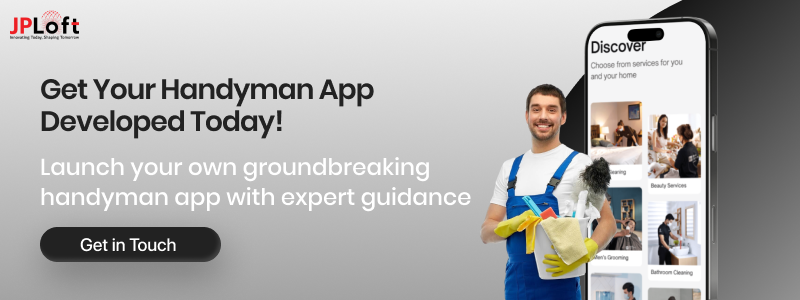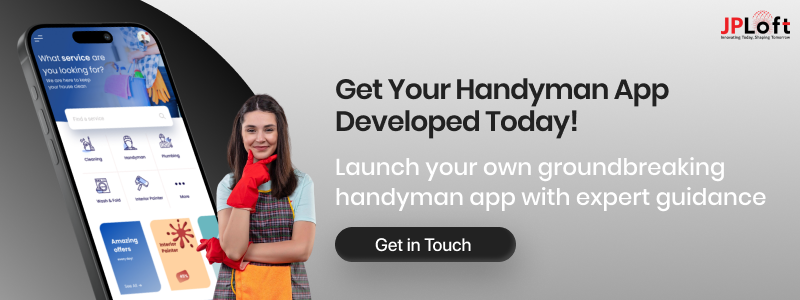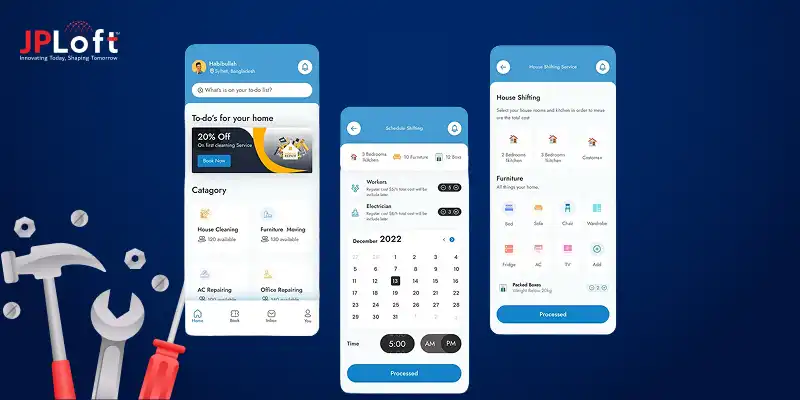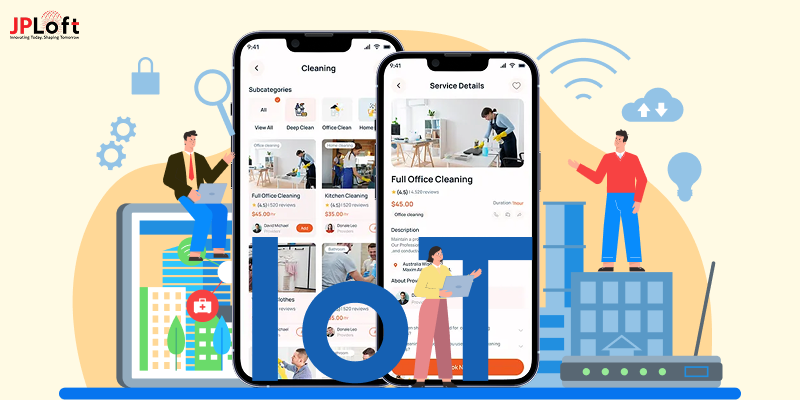The on-demand home service business has grown rapidly, with platforms like Urban Company setting a high standard.
If you are wondering how to create an app like Urban Company (UrbanClap), you need a well-structured approach covering market research, UI/UX design, development, and testing. A successful Handyman app should offer simple planning, safe payments, real-time tracking, and efficient service provider management.
To develop a handyman app like Urban Company, businesses must focus on user experience, advanced features, and solid server architecture.
In this guide, we’ll walk you through the essential steps to build a handyman app like Urban Company, covering features, prices, challenges, and revenue models to help you create a competitive on-demand service platform.
An Interesting Overview of Urban Company (UrbanClap)
With the advancing global landscape, Abhiraj Singh Bhal, Raghav Chandra, and Varun Khaitan, three young brains, came up with the innovative idea of developing a unique and powerful platform to connect service providers directly with their customers.
The Urban Company, previously known as UrbanClap, came into existence in 2014 when its founders decided to explore an undiscovered niche in the market.
The main motive of the company is to empower millions of professionals by providing a platform where they can earn by delivering the best home services.
Urban Company has evolved a lot since its launch. Let's take a quick look at the company's growth:
-
Currently, they operate across two primary verticals: beauty and Home Repairs & Maintenance. With a workforce of 40,000 skilled professionals, the company has already gained a vast base of happy customers.
-
Urban Company is a pioneer home service company that mostly operates in both India and the UAE.
-
Initially, they offered services in a few cities, but with time, they expanded their area of service. Now, they are available in 31 metropolitan cities in India.
-
Urban Company boosts its reach globally by provisioning services in neighbouring countries, such as Dubai, Abu Dhabi, Australia, and Singapore.
You can say that Urban Company or UrbanClap makes the lives of their customers better with their door-to-door home services.
How Does Urban Company App Work?
Urban Company or UrbanClap is a prime example of a solid handyman app that connects users with a variety of professional service providers, such as plumbers, electricians, and beauticians.
If you want to create an app like UrbanClap, then you should understand how it works:
A] User Registration
The first step for users is to download the Urban Company app and make an account. The app asks for personal information like contact details, email and preferred payment options.
B] Choosing Service
You can see various categories like home cleaning, salon on-demand services, repairs, and more on the home screen of the app. You just need to select the service you need and specify your availability.
C] Supplier Mapping
Once you choose a service, the app algorithm will match your needs with the most appropriate service providers. It considers location, accessibility and user reviews before recommending the service provider.
D] Booking Confirmation
After finding you a suitable professional, the app will provide you with information about them such as their name, photo, and arrival time. If you confirm the booking, then the service provider is alerted.
E] Service Delivery
The allotted service provider comes to a given location fully equipped with necessary tools and supplies. Urban Company keeps your preferences in mind and carries out services according to them.
F] Payment and Review
When the service is finished, you will receive an invoice. You can pay through the app using the already registered payment method.
You can also share reviews about the service provider based on the quality of their service and experience.
Now, let's move toward the next section to learn about the features that make it possible for the app to work effortlessly.
Key Features to Create an App Like Urban Company
An app like UrbanClap or Urban Company is an amazing service platform that offers convenience to its users and earns their trust. Here is the list of all the Handyman app features that make Urban Company a top player in the industry.
1. Admin Panel
The admin panel is the backbone of the app, ensuring smooth operations and efficient service management.
► Dashboard
The dashboard manages every ongoing and upcoming activity of your business properly.
► Request Management
Admins can control every service request received and assign it to the right service provider.
► Payment Management
With every request made on the platform, the app will get commissions and even supervise the payments of service providers, too.
► Analytics
Using analytics tools, admins can track app performance in detail and plan business strategies according to customer needs.
► Business Team Management
Manage the daily tasks, reports, business dealings, customer relationship management, transactions, etc., with this crucial feature on your platform.
2. Customer Panel
The customer panel provides users with a seamless experience to browse, book, and manage home services effortlessly.
► Profile Creation
Users can register through email, phone number, or Google Account.
► Browse Services
The feature lets users search for the services they want and find multiple options.
► Service History
Urban Company keeps the history of the user's purchases so that they can request the same service provider from the search history.
► Recommendations
The app will make recommendations for the users based on their service history, preferences, and likes or dislikes.
► Advanced Search
By applying several filters, users can make their searches easier.
► Subscription
The subscription feature allows users to unlock premium services for a fee for a certain period of time. Premium users get more advanced filters and discount offers on specific services.
► Safety Tools
The platform ensures the safety of users by delivering the right services and emergency buttons.
► Payment Gateway
A secure payment gateway into an app like Urban Company enables safe, fast, and easy transactions. Users can buy subscriptions or in-app products or services whenever they want.
► Customer Support
Users can contact customer support in case of any query, doubt, or question, helping to improve customer relationships.
3. Service Provider Panel
This panel allows service providers to manage their profiles, track requests, and handle payments efficiently.
► Registration
The service providers register their businesses on your app using their business email ID or mobile number. To ensure a secure login, social media accounts are linked.
► Profile Management
Businesses must fill in the basic details and various service information, making their business more accessible. Service providers are allowed to update their profiles regularly.
► Request Management
Once the user sends a home-service request, the service provider can accept or reject the request. They can schedule the appointment based on their availability.
► Schedule Confirmation
Following request acceptance, the service provider gets to work, providing the services based on the request's criteria. The user is notified about the important service details and confirmation.
► Payment Management
The feature allows service providers to manage their finances, like commissions, service charges, refunds, etc. They will receive a notification once the payment is made.
► Real-Time Tracking
This feature allows users and service providers to track locations via Google Maps and in-app communication. It helps them stay connected during service delivery.
► Additional Charges
Users can pay extra for additional services and enjoy comfort without worry. It also encourages businesses to add more services and benefits the service providers as well.
Once you learn about the features, you can say that you are now well-informed about the non-technical aspects of the Urban Company app.
To understand how to build an app like Urban Company, it is essential to explore the nuances of the handyman app development process. Let’s dive deep into the technical aspects to gain a clear understanding.
Comprehensive Guide to Build an App Like Urban Company
Building an app like Urban Company requires a clear strategy, deep market insights, and a step-by-step approach. If you aim to build a home service app like Urban Company, each stage of development is critical to your success.
Below is an in-depth guide explaining each step of the process:
1. Market Research
Before you begin, perform a comprehensive market study to understand the business landscape.
Analyze competitors, study user reviews, and identify gaps in existing offerings. Look at what makes Urban Company a leader in the market, its range of services, price structure, customer satisfaction, and operating efficiency.
Understand the target audience's needs and pain points. This study will help you find opportunities to differentiate your app. By gathering insights, you’ll be better positioned to develop an app similar to Urban Company that caters directly to your users’ demands.
2. Plan of Action
Once your study is complete, start by defining your goal.
Outline the goal of your app, its key performance indicators (KPIs), unique selling points (USPs), and main features. Consider your tech stack, target audience, launching platforms (iOS, Android, or both), and operating areas.
A well-structured plan serves as a template for your project and guides the entire handyman app development process. This detailed approach is crucial if you want to develop an app like UrbanClap or Urban Company that is not only useful but also competitive in the market.
3. Design the UI/UX
A user-friendly design is at the heart of any excellent app. Invest in building an engaging and easy design that catches users’ attention and makes movement simple.
Work with experienced UI/UX designers for prototyping, wireframing, and final visual designs. Ensure that the app’s style is clean and that every feature is easily available.
Smooth navigation and attractive visuals are key elements that help create a handyman app like Urban Company that keeps users coming back. Remember, the design should also align with your brand’s identity and resonate with your target audience.
4. Choose The Right Tech Stack
The technology stack plays a crucial role in the performance, scalability, and security of your app. Selecting the right tools and frameworks can significantly impact the speed of development and future expansion. Below are some key components to consider:
-
Frontend Development: React Native, Flutter, or Swift (iOS) and Kotlin (Android)
-
Backend Development: Node.js, Python (Django), or Ruby on Rails
-
Database Management: PostgreSQL, MongoDB, or Firebase
-
Cloud Hosting: AWS, Google Cloud, or Microsoft Azure
-
Payment Gateway Integration: Stripe, Razorpay, or PayPal
-
Real-Time Features: Twilio (for messaging) and Google Maps API (for tracking services)
Choosing a reliable tech stack will help you build an app like Urban Company that is not only feature-rich but also designed for speed and security.
5. Develop the MVP
The Minimum Viable Product (MVP) step is important. Start with an MVP that includes only the important features needed to start the app.
This might include user registration, service booking, payment processing, and simple real-time tracking. An MVP not only lowers startup costs but also allows you to gather early user feedback. Based on this feedback, you can improve the app with additional features.
This method helps you develop an app like UrbanClap in a phased way, ensuring that your investment is directed toward features that truly matter to your users.
6. App Development (Frontend and Backend)
After finishing your MVP, continue with the full-scale development.
Frontend development focuses on building the user interface and ensuring a smooth user experience, while backend handles server-side functions, databases, API connections, and security protocols.
Using sturdy, scalable technologies will be key in ensuring that your app can handle growth over time. Hire dedicated developers who are skilled in Urban Company-like app development and can help you combine advanced features such as real-time tracking, AI-powered suggestions, and changeable price models. The aim is to create an app that is responsive, safe, and user-friendly.
7. Third-Party Integrations
Modern apps depend on third-party services to improve functionality. Integrate reliable payment methods (like Stripe or PayPal), mapping and GPS tracking APIs (such as Google Maps or Mapbox), and communication tools (like Twilio) to improve operations.
These integrations lower development time and improve the general functionality of the app. When you make an app like Urban Company, ensuring that these third-party tools are well-integrated is important for a seamless user experience and business efficiency.
8. App Testing and Quality Assurance
Thorough app testing is important before launch.
Conduct multiple rounds of testing, including functional testing, speed testing, and security testing. Identify and fix bugs, check for compatibility problems across devices, and ensure that all features work as intended.
Testing not only improves speed in similar on-demand service apps but also ensures that your app is robust and ready for real-world use. User testing with real customers can provide useful feedback and help refine the app further.
9. App Deployment
Once your app passes all testing stages, it’s time to start.
Prepare for deployment by ensuring that all app store guidelines are met for both the Google Play Store and Apple App Store. Optimize your app store page with clear descriptions, high-quality pictures, and user reviews.
Launching with a smart marketing plan is crucial to gain initial success. A good launch sets the basis for long-term success and places your app as a strong competitor in the market.
By following these steps, you can build an app like Urban Company that meets market needs and stands out among competitors.
Whether you want to learn how to build an app like Urban Company, adhering to these rules will help you achieve a high-quality product that drives customer satisfaction and business growth.
Before you dive into the development phase, having a clear estimate of the cost and time required to develop an app like Urban Company (UrbanClap) will help you plan your budget and timeline efficiently.
Cost to Develop an App Like Urban Company
The cost of handyman development is one of the first things you should think about if you want to develop an app like Urban Company. Prices vary based on many factors, including the difficulty of the app, its features, its technology stack, and the skill level of the development team.
Between $30,000 and $70,000+ is the typical cost to create a home service app like Urban Company.
Around $30,000 to $40,000 will get you a basic version with basic features like user registration, service booking, payment connection, and service descriptions.
It can cost anywhere from $40,000 to $55,000 for a middle-level app with features like real-time tracking, in-app chat, statistics, and push alerts.
An advanced app, on the other hand, can cost more than $70,000 and have third-party connections, AI-based suggestions, and support for multiple languages.
The development team also affects how much it costs to make an app like Urban Company. It costs more to hire the best mobile app development company, but you'll get better results.
Smaller companies or freelancers might have lower prices, but they might not know how to build an app that can be used by many people and has many features.
Knowing the estimated Urban Company clone app development cost helps in budgeting and making informed choices for your business.
|
App Version |
Features Included |
Estimated Cost |
|
Basic Version |
User registration, service booking, and payment integration |
$30,000 - $40,000 |
|
Mid-Level Version |
Real-time tracking, chat support, analytics |
$40,000 - $55,000 |
|
Advanced Version |
AI-driven recommendations, multi-language support, third-party integrations |
$70,000+ |
Now, let’s see how long it takes to build a handyman app like Urban Company.
Timeframe for Urban Company-Like App Development
Developing a handyman app like Urban Company requires careful planning, designing, development, testing, and deployment. The entire process can take anywhere between 6 to 12 months or more, depending on the complexity of the app, the development team, and the features included.
Below is an estimated development timeline for an Urban Company clone app:
|
Phase |
Estimated Timeframe |
|
Research & Planning |
2–4 Weeks |
|
UI/UX Design |
4–6 Weeks |
|
Development (MVP) |
12–16 Weeks |
|
Advanced Features Integration |
8–12 Weeks |
|
Testing & QA |
6–8 Weeks |
|
Launch Preparation |
2–3 Weeks |
|
Launch & User Feedback |
1–2 Weeks |
|
Post-Launch Updates & Maintenance |
Ongoing |
The timeline to build an Urban Company-like app may vary based on the team size, technology stack, and additional features required.
Business And Revenue Models For Urban Company
An app like Urban Company operates on various business models.
Here are the top revenue models that are implemented by Urban Company, helping them to generate millions:
A] Commission-Based Model
85% of the revenue generated by Urban Company comes from this model.
In this model, the company works as a middleman, where they take a certain amount of commission from the professionals for every job they receive from the platform.
For each different service, there is a different commission. The more work the professionals receive, the more money the company will earn.
B] Lead Generation Model
Another model used by the Urban Company to generate profit is lead generation. In this mode, professionals have to pay once they get leads from the platform.
Moreover, if the customer demands special requirements, he/she can either contact the professional mentioned by Urban Company or contact other professionals after seeing the listed job with requirements. Once the customer books the professional, the company will charge them for lead generation.
C] Subscription Model
Urban Company follows a subscription-based revenue model where service providers can opt for premium plans to enhance their visibility on the platform.
These subscriptions offer benefits like higher-ranking profiles, priority access to leads, and exclusive marketing tools to attract more customers. By subscribing to these plans, professionals increase their chances of getting booked, making it a win-win for both the platform and the service provider.
This model ensures a steady revenue stream for Urban Company while enabling skilled professionals to expand their customer base.
D] Advertisement & Featured Listings
To further boost earnings, Urban Company allows professionals to pay for advertising and featured listings.
Service providers can promote their services by appearing in top search results or highlighted sections, ensuring better exposure and higher booking rates. These advertisements can be displayed based on location, service category, or user preferences, making it easier for customers to find relevant professionals.
This pay-per-click generates extra revenue for the platform while helping professionals stand out in a competitive market.
E] Product Sales & Tools Supply
Urban Company also monetizes by selling essential tools, products, and kits required by service professionals.
From salon kits and cleaning supplies to plumbing tools, the platform acts as a marketplace where service providers can conveniently purchase high-quality equipment.
This e-commerce-like model not only ensures that professionals have access to the best tools but also brings in additional revenue.
Challenges And Solutions in Developing an Urban Company-Like App
Developing an on-demand handyman app like Urban Company involves multiple complexities. From technical handyman app challenges to user acquisition hurdles, businesses need to tackle several obstacles to ensure a seamless and scalable platform.
Here are some common challenges and their solutions when you create a home service app like Urban Company.
1. Ensuring Seamless User Experience
A home service app must offer a smooth and intuitive experience for both service providers and customers. A complicated UI can lead to higher drop-off rates.
Solution: Invest in professional UI/UX design to build an easy-to-navigate and visually appealing interface. Conduct A/B testing and implement user feedback to improve usability.
2. Matching Users with the Right Service Providers
One of the biggest challenges when you build a home service app like Urban Company is ensuring accurate service-provider matching based on user needs, location, availability, and ratings.
Solution: Implement AI-powered algorithms and machine learning models to enhance personalized recommendations and ensure efficient service allocation.
3. Managing Multiple Services and Pricing Models
Unlike single-service apps, Urban Company-like app development requires handling multiple services, each with different pricing structures.
Solution: Use dynamic pricing models and automated invoicing systems to adjust service rates based on demand, location, and provider expertise.
4. Secure Payment Integration
Customers prefer hassle-free and secure payment options when booking services. Any glitches in payment processing can impact trust and credibility.
Solution: Integrate multiple payment gateways like credit/debit cards, wallets, and UPI while ensuring PCI DSS compliance to safeguard transactions.
5. Retaining Users and Service Providers
A major hurdle in building a handyman app like Urban Company is keeping both users and service providers engaged as they often explore multiple platforms.
Solution: Offer loyalty programs, referral bonuses, and exclusive deals for users. For service providers, provide better revenue share, training support, and promotional tools to encourage long-term association.
6. Handling Real-Time Bookings & Cancellations
Managing last-minute bookings and cancellations without affecting service quality is a tough challenge in Urban Company clone app development.
Solution: Implement real-time scheduling, allow rescheduling, and introduce a penalty system for last-minute cancellations to ensure seamless operations.
By addressing these challenges effectively, you can create an app like Urban Company that is reliable, scalable, and user-friendly. Partnering with the on-demand app development company can help you navigate these obstacles and build a competitive on-demand platform.
Build a Robust Handyman App Like UrbanClap with JPLoft
Creating an excellent home service app like Urban Company takes expert planning, the right technology, and a skilled development team. At JPLoft, we specialize as a handyman app development company, providing high-quality, scalable, and feature-rich apps suited to your business needs.
With years of experience in on-demand app development, our team ensures a seamless user experience, advanced features, and a strong backend. Whether you need a basic MVP or a full-fledged multi-service platform, we provide personalized solutions that fit your budget and schedule.
Partner with JPLoft, a top company, and turn your business idea into a reality. Contact us today to discuss your project and take the first step toward building a high-performing handyman service app.
Conclusion
Building an app like Urban Company requires careful planning, the right technology stack, and a deep understanding of user needs. From conducting thorough market research to implementing advanced features, every step plays a crucial role in ensuring your app’s success.
To develop a handyman app like Urban Company, businesses must focus on seamless user experience, secure payment gateways, and efficient service provider management.
While challenges like high development costs and technical complexities may arise, choosing the right development partner can streamline the process.
If you are ready to build a handyman app like Urban Company, now is the perfect time to enter the growing home service market. A well-designed, feature-rich app can help you stand out and attract a loyal user base, ensuring long-term success in the competitive on-demand service industry.
FAQs
The cost varies based on factors like features, design complexity, development team location, and platform (Android, iOS, or both). A basic app may start at $30,000-$70,000, while an advanced app with AI and real-time tracking can exceed $70,000.
Key features include user registration, service listings, booking and scheduling, real-time tracking, secure payments, ratings and reviews, and push notifications. An admin panel for service provider management is also crucial.
Development time depends on the app’s complexity. A basic version may take 3-6 months, while a feature-rich app with advanced integrations can take 9-12 months.
Yes! Monetization strategies include commission-based earnings from service providers, subscription plans, featured listings, in-app advertisements, and surge pricing for peak hours.
Yes, it’s best to have separate interfaces or apps for customers and service providers. The customer app focuses on booking services, while the provider app manages requests, payments, and schedules.
To develop an app like Urban Company, you should conduct a market study, need to specify the design, build the core tech stack, perform testing, and then deploy and maintain the app to stand out in the competitive market.













Share this blog